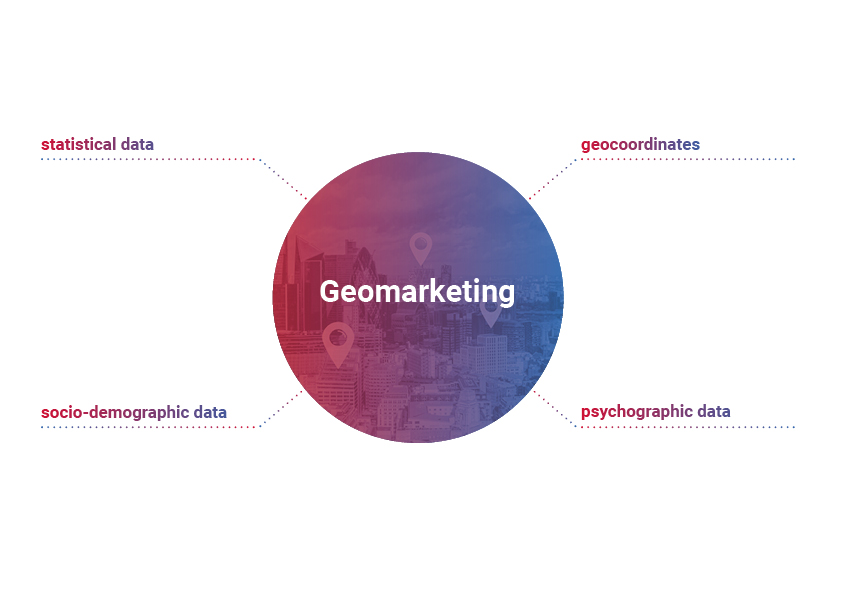Intelligently add a spatial dimension to addresses with geomarketing

How to use geographic data in marketing to support business decisions.
Having high-quality data is a great thing. In many scenarios, such as personalized campaigns in marketing, this is critical to success. But what about the spatial, the geographic dimension? How, for example, do you identify from your data pool where your target group can be found spatially, or to whom exactly do you send the mailing for your product offering in the high-priced segment, for example? Or to put it another way: to whom do you offer what and where? Exactly, this is where geomarketing comes into play.

What exactly is Geomarketing?
Geomarketing is the interface between geography and marketing. At its core, geomarketing combines spatial information with marketing strategies to enable informed decision-making. Taking geographical factors into account gives companies the opportunity to better understand potential customers (customer insights), segment markets, and thereby deploy resources efficiently.
The spatial or geographic information added to a postal address includes not only the geocoordinates, consisting of longitude and latitude, but other categories of data such as statistical, psychographic and socio-demographic data.
Socio-demographic data, for example, provides a better understanding of the population in certain regions. Psychographic data describes desires and inclinations, for example. Geo-coordinates offer the possibility to analyze geographic patterns and distances. Combined, these data sources open up a comprehensive picture for strategic decision-making.
The basic prerequisite for this data enrichment is high-quality addresses. This means that the postal data must be of an appropriate nature, the data quality. This includes that they are complete, correct, unambiguous and up-to-date. Otherwise, there is a risk of mis-enrichment and false findings that are misleading. For high-quality data, address validation and identity resolution are primarily used.
If the quality of the addresses is adequate, data enrichment works. The end result is answers to questions like 'Where does it make the most sense to open my organic supermarket?' or 'To whom in my data pool can I send the high-priced value-added offer?'.
Various application scenarios in geomarketing
The fields of application of geomarketing are diverse. They range from location assessment to target group analysis:
By combining geographic and demographic data, decision-makers can identify optimal locations for branches and subsidiaries that meet the needs of target groups.
Geomarketing allows customers to be segmented based on their spatial and, for example, socio-demographic characteristics. This allows highly personalized marketing campaigns to be developed that are even better tailored to the needs and preferences of specific groups of people in their regions.
Companies, for example from the CEP (courier, express, parcel) sector or delivery services, can plan optimal routes to shorten delivery times, reduce costs and meet sustainability requirements. This is because it is not only necessary to determine a route between a starting point and a destination, but a route that optimally connects a series of intended stopovers. For example, taking into account information on whether a building is used for business or private purposes in route planning can help to increase the probability of delivery.
Mapping competitors in a particular region, for example, before a retail chain opens a new store, makes it possible to explore and understand positioning in comparison to one's own and to make strategic decisions. On the basis of the insights gained, targeted positioning can be sought as an alternative, e.g., via certain product range components or special home services.
Geomarketing - more value for decision-makers
Since the combination of high-quality addresses with additional data provides valuable insights that are enormously helpful in the customer journey, for example, there is tangible added value for decision-makers in companies:
- More accurate decisions:
Companies gain more accurate insights into the needs of their target groups. Better-informed decisions are made (insight-driven). - Efficient use of resources:
Whether campaigns, route planning, location issues and and - given resources can be used more loss-free thanks to a spatial view. - Customer loyalty:
Tailored, locally relevant offers can help improve customer loyalty. - Early detection of trends:
Geomarketing helps to identify emerging trends and enables quick action.
The ethical dimension of geomarketing
In addition to looking at the benefits of geomarketing, it is important to consider the ethical dimension. For example, the use of location data raises questions about data protection and privacy. Accordingly, on the part of the legislator, data enrichment may only take place up to a certain granularity. To ensure that no conclusions can be drawn about specific individuals or individual households, data is enriched to the level of so-called microcells with several households and thus individuals. In this context, companies must handle the data transparently and responsibly. It must be ensured that they comply with applicable data protection regulations.
In addition, attention must be paid to up-to-dateness. Data for geomarketing changes over time. Therefore, it is important to update this data regularly to ensure permanently up-to-date analyses.
Analyzing enriched data in geomarketing requires experienced, knowledgeable interpretation to draw accurate conclusions and make informed decisions. For example, do I close a store purely for economic reasons? Or might other factors, such as social responsibility and image, need to be included because certain segments of the population will be negatively affected by the store closure?
Nothing good unless you do it
Geomarketing has transformed itself from a niche of simple statistics to a best practice method. It enables companies to add spatial aspects to postal addresses of customers and prospects. Accordingly, strategic decisions are made on the basis of sound data instead of in a vacuum. In special combination with high-quality data, geomarketing thus opens up a more precise view of markets, customer behavior and the competitive environment.
By helping you to keep your data accurate, up-to-date and complete and to enrich it accordingly, we enable you to build your geomarketing strategies on reliable foundations.
Learn more about our geocoding solution here or test our solution directly in our CONNECT portal:
You might also be interested in:


